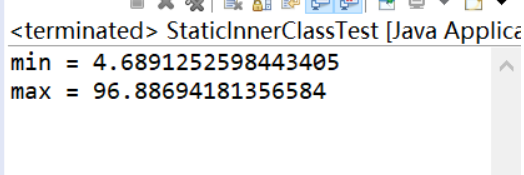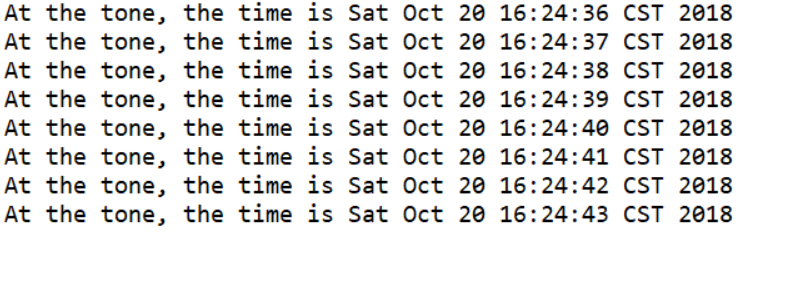第一部分:理论知识
一、接口、lambda和内部类; Comparator与comparable接口;
1.comparable接口的方法是compareTo,只有一个参数;comparator接口的方法是compare,有两个参数。
comparator自定义比较器。comparable实现接口。
2.对象克隆
1 深拷贝与浅拷贝。如果对象是不可变的,那么默认的浅拷贝也没有问题;否则,就要使用深拷贝。
2)默认的克隆方法是浅拷贝,clone方法是Object的一个protected方法。
3) 要让一个对象可以克隆,则需要如下步骤:
a.实现cloneable接口
b.重定义clone方法,并指定public访问修饰符。
c.重定义的clone方法要逐一拷贝每一个域。
4.如果一个要clone的对象没有实现cloneable接口,那么编译器就会抛出一个CloneNotSupportedException异常。
形似cloneable这样的接口叫做标记接口,标记接口没有实现任何的方法,他的作用只是允许在类型查询中使用instanceOf。
即便默认浅拷贝能够满足要求,还是徐亚需要实现Cloneable接口,将clone重新定义为public,再调用super.clone().
5.lambda表达式
1) 传代码而非传值。
2) lambda的语法规则:(参数)->以及一个表达式
3)如果计算无法在一个表达式中完成,那么就使用{}。
4)即使lambda没有参数,任然要提供空括号,就算无参方法一样。
5)如果可以推导出一个lambda表达式的参数类型,则可以忽略其类型。
6)如果方法只要一个参数,而且这个 参数的类型可以推导得出,那么甚至可以省略小括号。
6)无需指定lambda表达式的返回类型。lambda表达式返回类型总可以由上下文推导出。
7)如果一个lambda表达式只在某些分支返回一个值,而在另一些分支不返回,这是不合法的。
8)只有一个抽象方法的接口,称为函数式接口。
9)lambda表达式中捕获的变量必须是最终变量,这个变量初始化之后就不能再为他赋新值,不能做更改。
10)在lambda表达式中,声明一个与局部变量同名的参数或局部变量是不可合法的。
11)在一个lambda表达式中使用this关键字,是指创建这个lambda表达式的方法的this参数。
6.内部类
作用:内部类方法可以访问外围类的数据,包括私有的数据.
内部类可以对同一个包种的其他类隐藏起来.
使用anonymous内部类定义回调函数类.
第二部分:实验部分
1、实验目的与要求
(1) 掌握接口定义方法;
(2) 掌握实现接口类的定义要求;
(3) 掌握实现了接口类的使用要求;
(4) 掌握程序回调设计模式;
(5) 掌握Comparator接口用法;
(6) 掌握对象浅层拷贝与深层拷贝方法;
(7) 掌握Lambda表达式语法;
(8) 了解内部类的用途及语法要求。
2、实验内容和步骤
实验1: 导入第6章示例程序,测试程序并进行代码注释。
测试程序1:
l 编辑、编译、调试运行阅读教材214页-215页程序6-1、6-2,理解程序并分析程序运行结果;
l 在程序中相关代码处添加新知识的注释。
l 掌握接口的实现用法;
l 掌握内置接口Compareable的用法。
package interfaces;
2
3 public class Employee implements Comparable<Employee>
4 {
5 //声明属性;
6 private String name;
7 private double salary;
8 //构造方法;
9 public Employee(String name, double salary)
10 {
11 this.name = name;
12 this.salary = salary;
13 }
14 //Name属性访问器;
15 public String getName()
16 {
17 return name;
18 }
19 //Salary属性访问器;
20 public double getSalary()
21 {
22 return salary;
23 }
24 //计算工资方法;
25 public void raiseSalary(double byPercent)
26 {
27 double raise = salary * byPercent / 100;
28 salary += raise;
29 }
30
31 /**
32 * Compares employees by salary
33 * @param other another Employee object
34 * @return a negative value if this employee has a lower salary than
35 * otherObject, 0 if the salaries are the same, a positive value otherwise
36 */
37
38 public int compareTo(Employee other)//compareTo方法;
39 {
40 return Double.compare(salary, other.salary);//包装器 调用compare方法;
41 }
42 }
package interfaces;
2
3 import java.util.*;
4
5 /**
6 * This program demonstrates the use of the Comparable interface.
7 * @version 1.30 2004-02-27
8 * @author Cay Horstmann
9 */
10 public class EmployeeSortTest
11 {
12 public static void main(String[] args)
13 {
14 //构建数组对象;
15 Employee[] staff = new Employee[3];
16 //用三个staff对象填充数组;
17 staff[0] = new Employee("Harry Hacker", 35000);
18 staff[1] = new Employee("Carl Cracker", 75000);
19 staff[2] = new Employee("Tony Tester", 38000);
20
21 Arrays.sort(staff);//按字母排序方法;
22
23 // print out information about all Employee objects
24 for (Employee e : staff)
25 System.out.println("name=" + e.getName() + ",salary=" + e.getSalary());
26 }
27 }
测试结果如下所示
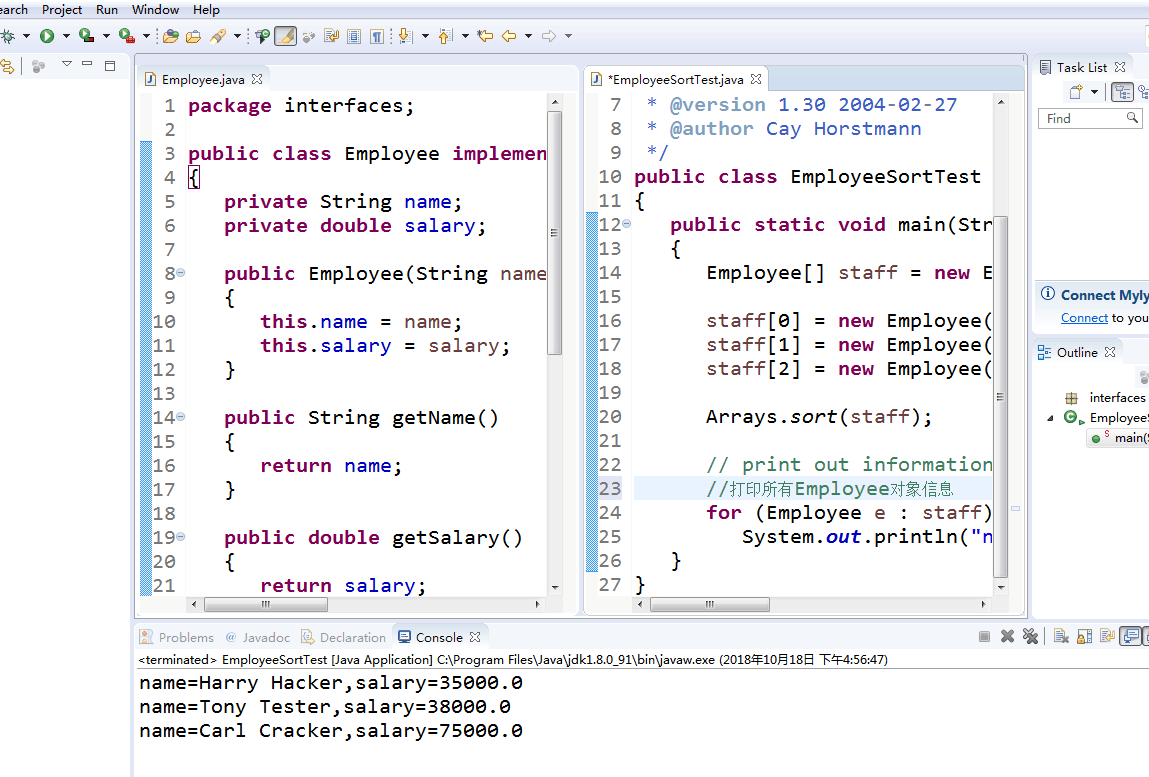
测试程序2:
l 编辑、编译、调试以下程序,结合程序运行结果理解程序;
interface A
2 {
3 double g=9.8;
4 void show( );
5 }
6 class C implements A
7 {
8 public void show( )
9 {System.out.println("g="+g);}
10 }
11
12 class InterfaceTest
13 {
14 public static void main(String[ ] args)
15 {
16 A a=new C( );
17 a.show( );
18 System.out.println("g="+C.g);
19 }
20 }
public interface A
2 {
3 double g=9.8;
4 void show( );
5 }
6
7
8
9
10 public class C implements A
11 {
12 public void show( )
13 {System.out.println("g="+g);}
14 }
19 public class InterfaceTest
20 {
21 public static void main(String[ ] args)
22 {
23 A a=new C( );
24 a.show( );
25 System.out.println("g="+C.g);
26 }
27 }
测试结果如下所示
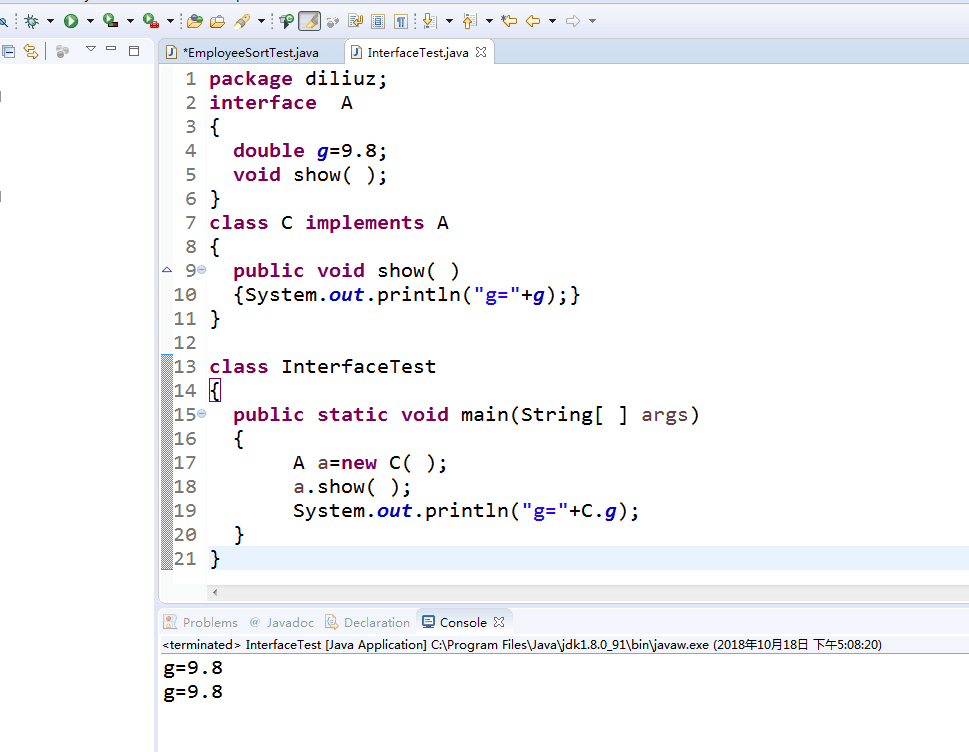
测试程序3:
l 在elipse IDE中调试运行教材223页6-3,结合程序运行结果理解程序;
l 26行、36行代码参阅224页,详细内容涉及教材12章。
l 在程序中相关代码处添加新知识的注释。
l 掌握回调程序设计模式;
package timer;
2
3 /**
4 @version 1.01 2015-05-12
5 @author Cay Horstmann
6 */
7
8 import java.awt.*;
9 import java.awt.event.*;
10 import java.util.*;
11 import javax.swing.*;
12 import javax.swing.Timer;
13 // 解决与java.util.Timer的矛盾
14
15 public class TimerTest
16 {
17 public static void main(String[] args)
18 {
19 ActionListener listener = new TimePrinter();
20
21 //构造一个调用侦听器的计时器;
22 //每十秒一次;
23 Timer t = new Timer(10000, listener);
24 t.start();
25
26 JOptionPane.showMessageDialog(null, "Quit program?");
27 System.exit(0);
28 }
29 }
30
31 class TimePrinter implements ActionListener
32 {
33 public void actionPerformed(ActionEvent event)
34 {
35 System.out.println("At the tone, the time is " + new Date());
36 Toolkit.getDefaultToolkit().beep();
37 }
38 }
测试结果如下所示
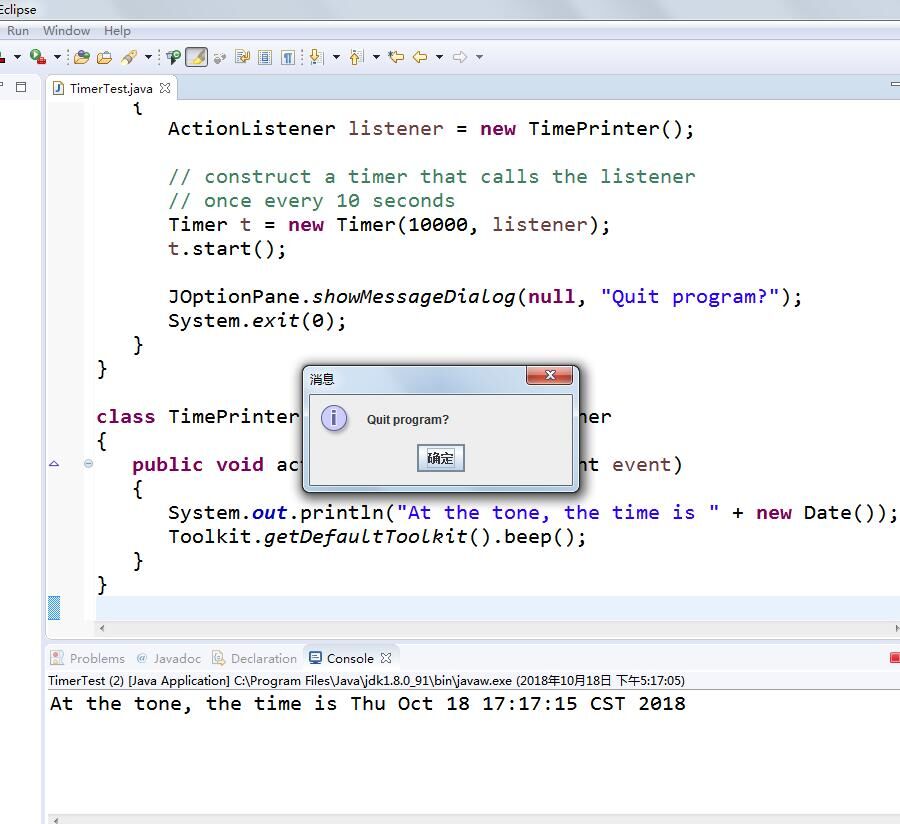
测试程序4:
l 调试运行教材229页-231页程序6-4、6-5,结合程序运行结果理解程序;
l 在程序中相关代码处添加新知识的注释。
l 掌握对象克隆实现技术;
l 掌握浅拷贝和深拷贝的差别。
实验2: 导入第6章示例程序6-6,学习Lambda表达式用法。
l 调试运行教材233页-234页程序6-6,结合程序运行结果理解程序;
l 在程序中相关代码处添加新知识的注释。
l 将27-29行代码与教材223页程序对比,将27-29行代码与此程序对比,体会Lambda表达式的优点。
package Lambda;
2
3 import java.util.*;
4
5 import javax.swing.*;
6 import javax.swing.Timer;
7
8 /**
9 * This program demonstrates the use of lambda expressions.
10 * @version 1.0 2015-05-12
11 * @author Cay Horstmann
12 */
13 public class LambdaTest
14 {
15 public static void main(String[] args)
16 {
17 //定义并初始化string类数组;
18 String[] planets = new String[] { "Mercury", "Venus", "Earth", "Mars",
19 "Jupiter", "Saturn", "Uranus", "Neptune" };
20 //排序前输出;
21 System.out.println(Arrays.toString(planets));
22 System.out.println("Sorted in dictionary order:");
23 Arrays.sort(planets);
24 System.out.println(Arrays.toString(planets));//按字母顺序排序输出;
25 System.out.println("Sorted by length:");
26 //按单词长度排序后,使用lambda表达式;
27 Arrays.sort(planets, (first, second) -> first.length() - second.length());
28 System.out.println(Arrays.toString(planets));//
29 //方法引用;lambda表达式;
30 Timer t = new Timer(1000, event ->
31 System.out.println("The time is " + new Date()));//每隔一秒输出当前时间;
32 t.start();
33
34 // 继续运行程序,知道用户选择OK;
35 JOptionPane.showMessageDialog(null, "Quit program?");
36 System.exit(0);
37 }
38 }
测试结果如下所示
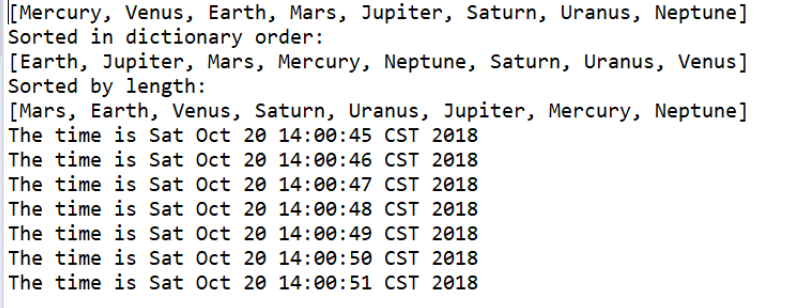
实验3: 编程练习
l 编制一个程序,将身份证号.txt 中的信息读入到内存中;
l 按姓名字典序输出人员信息;
l 查询最大年龄的人员信息;
l 查询最小年龄人员信息;
l 输入你的年龄,查询身份证号.txt中年龄与你最近人的姓名、身份证号、年龄、性别和出生地;
l 查询人员中是否有你的同乡。
import java.io.BufferedReader; import java.io.File; import java.io.FileInputStream; import java.io.FileNotFoundException; import java.io.IOException; import java.io.InputStreamReader; import java.util.ArrayList; import java.util.Arrays; import java.util.Collections; import java.util.Scanner; public class M{ private static ArrayList<Test> studentlist; public static void main(String[] args) { studentlist = new ArrayList<>(); Scanner scanner = new Scanner(System.in); File file = new File("D:\身份证号.txt"); try { FileInputStream fis = new FileInputStream(file); BufferedReader in = new BufferedReader(new InputStreamReader(fis)); String temp = null; while ((temp = in.readLine()) != null) { Scanner linescanner = new Scanner(temp); linescanner.useDelimiter(" "); String name = linescanner.next(); String number = linescanner.next(); String sex = linescanner.next(); String age = linescanner.next(); String province =linescanner.nextLine(); Test student = new Test(); student.setName(name); student.setnumber(number); student.setsex(sex); int a = Integer.parseInt(age); student.setage(a); student.setprovince(province); studentlist.add(student); } } catch (FileNotFoundException e) { System.out.println("学生信息文件找不到"); e.printStackTrace(); } catch (IOException e) { System.out.println("学生信息文件读取错误"); e.printStackTrace(); } boolean isTrue = true; while (isTrue) { System.out.println("1:字典排序"); System.out.println("2:输出年龄最大和年龄最小的人"); System.out.println("3:寻找老乡"); System.out.println("4:寻找年龄相近的人"); System.out.println("5:退出"); String m = scanner.next(); switch (m) { case "1": Collections.sort(studentlist); System.out.println(studentlist.toString()); break; case "2": int max=0,min=100; int j,k1 = 0,k2=0; for(int i=1;i<studentlist.size();i++) { j=studentlist.get(i).getage(); if(j>max) { max=j; k1=i; } if(j<min) { min=j; k2=i; } } System.out.println("年龄最大:"+studentlist.get(k1)); System.out.println("年龄最小:"+studentlist.get(k2)); break; case "3": System.out.println("province?"); String find = scanner.next(); String place=find.substring(0,3); for (int i = 0; i <studentlist.size(); i++) { if(studentlist.get(i).getprovince().substring(1,4).equals(place)) System.out.println("province"+studentlist.get(i)); } break; case "4": System.out.println("年龄:"); int yourage = scanner.nextInt(); int near=agematched(yourage); int value=yourage-studentlist.get(near).getage(); System.out.println(""+studentlist.get(near)); break; case "5": isTrue = false; System.out.println("退出程序!"); break; default: System.out.println("输入有误"); } } } public static int agematched(int age) { int j=0,min=53,value=0,k=0; for (int i = 0; i < studentlist.size(); i++) { value=studentlist.get(i).getage()-age; if(value<0) value=-value; if (value<min) { min=value; k=i; } } return k; } } M
import java.io.BufferedReader; import java.io.File; import java.io.FileInputStream; import java.io.FileNotFoundException; import java.io.IOException; import java.io.InputStreamReader; import java.util.ArrayList; import java.util.Arrays; import java.util.Collections; import java.util.Scanner; public class M{ private static ArrayList<Test> studentlist; public static void main(String[] args) { studentlist = new ArrayList<>(); Scanner scanner = new Scanner(System.in); File file = new File("D:\身份证号.txt"); try { FileInputStream fis = new FileInputStream(file); BufferedReader in = new BufferedReader(new InputStreamReader(fis)); String temp = null; while ((temp = in.readLine()) != null) { Scanner linescanner = new Scanner(temp); linescanner.useDelimiter(" "); String name = linescanner.next(); String number = linescanner.next(); String sex = linescanner.next(); String age = linescanner.next(); String province =linescanner.nextLine(); Test student = new Test(); student.setName(name); student.setnumber(number); student.setsex(sex); int a = Integer.parseInt(age); student.setage(a); student.setprovince(province); studentlist.add(student); } } catch (FileNotFoundException e) { System.out.println("学生信息文件找不到"); e.printStackTrace(); } catch (IOException e) { System.out.println("学生信息文件读取错误"); e.printStackTrace(); } boolean isTrue = true; while (isTrue) { System.out.println("1:字典排序"); System.out.println("2:输出年龄最大和年龄最小的人"); System.out.println("3:寻找老乡"); System.out.println("4:寻找年龄相近的人"); System.out.println("5:退出"); String m = scanner.next(); switch (m) { case "1": Collections.sort(studentlist); System.out.println(studentlist.toString()); break; case "2": int max=0,min=100; int j,k1 = 0,k2=0; for(int i=1;i<studentlist.size();i++) { j=studentlist.get(i).getage(); if(j>max) { max=j; k1=i; } if(j<min) { min=j; k2=i; } } System.out.println("年龄最大:"+studentlist.get(k1)); System.out.println("年龄最小:"+studentlist.get(k2)); break; case "3": System.out.println("province?"); String find = scanner.next(); String place=find.substring(0,3); for (int i = 0; i <studentlist.size(); i++) { if(studentlist.get(i).getprovince().substring(1,4).equals(place)) System.out.println("province"+studentlist.get(i)); } break; case "4": System.out.println("年龄:"); int yourage = scanner.nextInt(); int near=agematched(yourage); int value=yourage-studentlist.get(near).getage(); System.out.println(""+studentlist.get(near)); break; case "5": isTrue = false; System.out.println("退出程序!"); break; default: System.out.println("输入有误"); } } } public static int agematched(int age) { int j=0,min=53,value=0,k=0; for (int i = 0; i < studentlist.size(); i++) { value=studentlist.get(i).getage()-age; if(value<0) value=-value; if (value<min) { min=value; k=i; } } return k; } } M
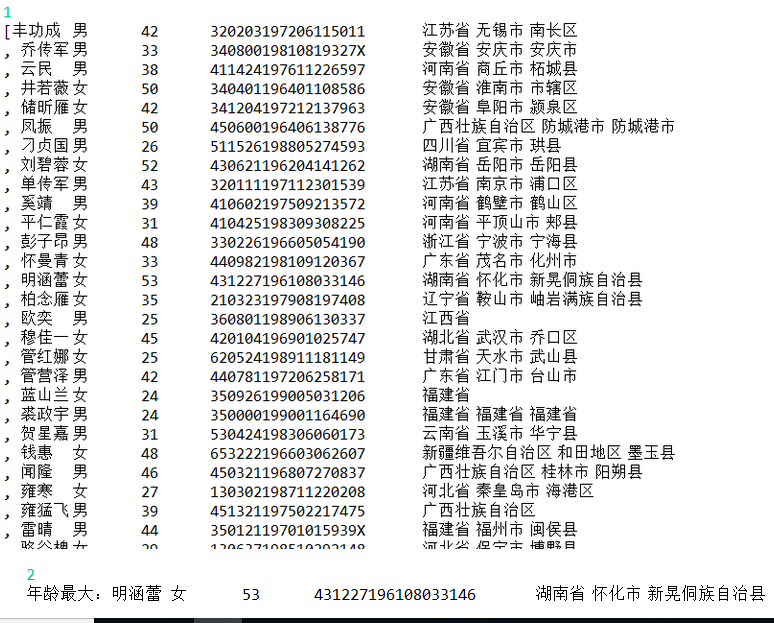


实验4:内部类语法验证实验
实验程序1:
l 编辑、调试运行教材246页-247页程序6-7,结合程序运行结果理解程序;
l 了解内部类的基本用法。



